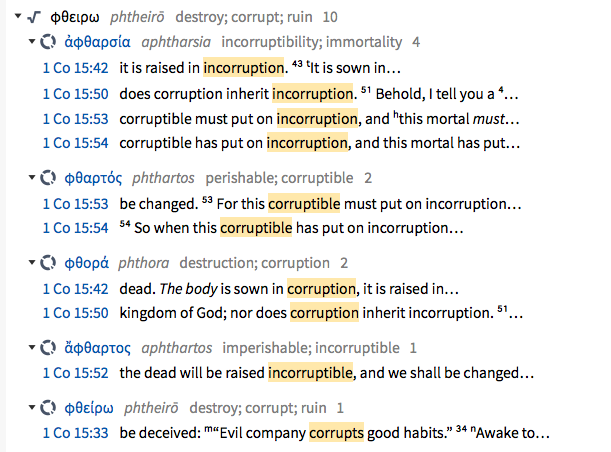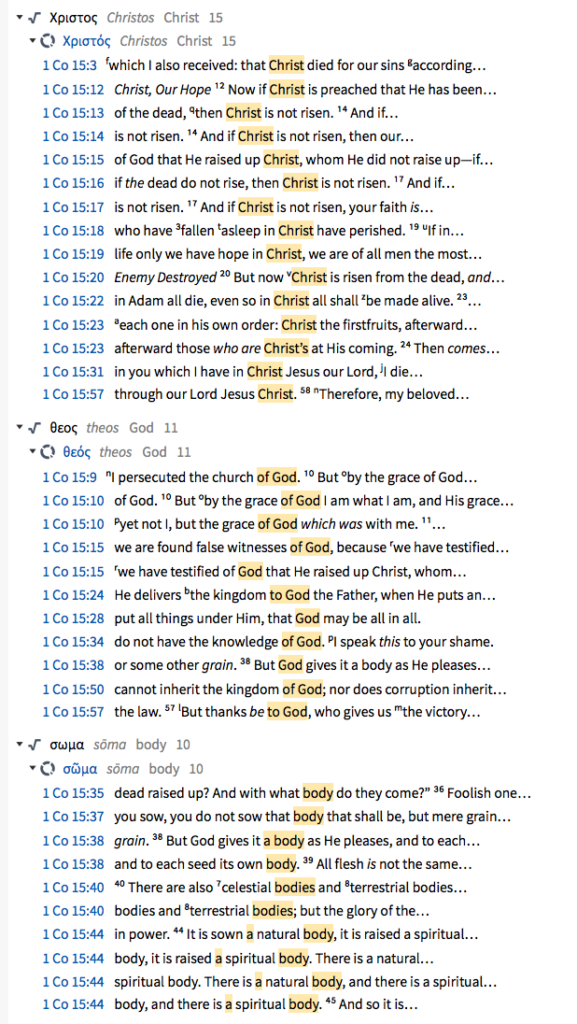Updated 5/10/18
1 Cor 15 is a very long chapter, the longest chapter of any Epistle or the Book of Revelation. The number of verses, or chapters themselves, is not significant from a Bible mss standpoint as these were added by publishers many centuries after the writing of the Bible, along with the various headings often included in printed Bibles (these headings are called “pericopes”). However the length of this chapter does suggest that the subject matter is a complex integrated discourse requiring some length before moving onto the matters in Ch 16, closing chapter of this epistle.
An important Gr word occurs three times in the opening two verses that headlines the entire subject of the chapter: eu-angelion (Strong’s G2097 and G2098). The word means, literally “good news”–also known as the Gospel–either as a noun, or the proclaiming of good news as a verb. The “eu” comes into many English words like “eulogy,” which means, literally “good words,” such as normally spoken in a memorial service of someone who has died. “Angelion” is of course the source of our English word “angel.” But the Gr root word (angelion) does not mean exclusively a heavenly spirit being, but can be any any messenger, including a human, as is the case in the very writing of the Corinthian Epistles. The essential point is that we are being given a message from God, in this case by means of a writing through the hand of an divinely appointed and enabled human (here the Apostle Paul) under the control of the Holy Spirit, and that message (news) is good, actually very very good. Further “euangelion” has been transliterated into our everyday English as our words (1) evangelical, (2) evangelize, and (3) evangelist, all of which mean, Biblically-speaking, (1) concerned with Good News (the Gospel), (2) communication of the Good News (the Gospel), and (3) being an actual communicator of the Good News (the Gospel).
Study resources for 1 Cor 15 are below.
Text of 1 Cor 15
1 Cor 15 in the NKJV with transliterated lemmas* and Strong’s numbers** is available here:
1 Cor 15 Clausal, Transliterated Lemma, Strongs.
The above pdf can be printed out in regular 8-1/2 by 11 portrait format or, if your printer supports such, it can be printed in “booklet” form, one of the available options on the Adobe pdf print screen.
*Lemmas are the dictionary form of the manuscript word (mss), as would be the English word “faith” for the mss words “faithful,” “faithfully,” etc.. Transliterated means that each letter of the Gr lemma is replaced with an English equivalent letter.
**Strong’s numbers are a means of searching for the given lemmas occurrences in the NT and even other ancient Gr literature, and for definitions (“Lexicons” which provide English definitions for Gr words).
A simpler, two column version of 1 Cor 15 is given here:
1 Cor 15 NIV, ESV
The Most Notable Words in 1 Cor 15
One not-everyday-word occurs 19 times in this single chapter (1 Cor 15): egeiro, Strong’s G1453, and in related forms. Below is a chart showing their many occurrences: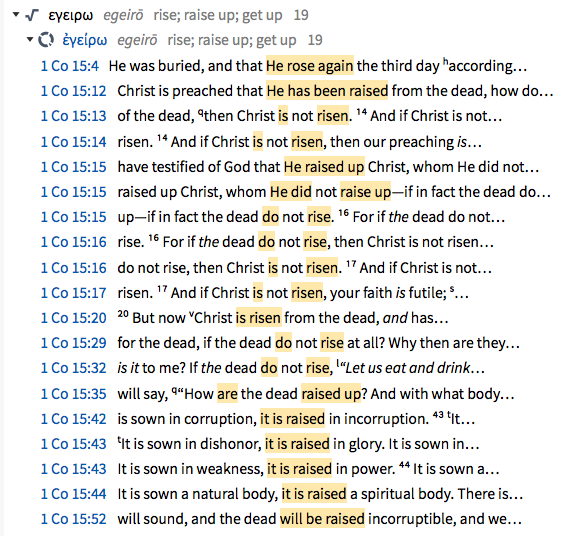 This word, egeiro, is about the essential claim of the Christian faith, namely the resurrection of the dead. It has the pictorial image of that which was once upright and is now fallen flat and utter incapable of ever rising again by its own power, being dead, is by the hand of God being raised upright. It is what God the Father did on behalf of God the Son, Jesus Christ, and will do on our behalf as well, if we are in Christ.
This word, egeiro, is about the essential claim of the Christian faith, namely the resurrection of the dead. It has the pictorial image of that which was once upright and is now fallen flat and utter incapable of ever rising again by its own power, being dead, is by the hand of God being raised upright. It is what God the Father did on behalf of God the Son, Jesus Christ, and will do on our behalf as well, if we are in Christ.
Here’s a very complex single sentence from the Epistle to the Hebrews that is worthy of deep consideration on this point.
Hebrews 15: 20 Now may the God of peace
who brought up our Lord Jesus from the dead,
that great Shepherd of the sheep,
through the blood of the everlasting covenant,
21 make you complete in every good work to do His will,
working in you what is well pleasing in His sight,
through Jesus Christ, to whom be glory forever and ever.
Amen.
The bookend word to egeiro (resurrection) is the words for death. The words for “death” occur 28 times in this chapter. Death is the great reality of life. No one escapes it. And its reality affects us all in that it calls to mind the basic questions of what is the purpose of life / living itself. If it all ends anyway, and it will likewise end for everyone we know and will ever know, so that in a 100 years or so, no one then alive will even know in any real sense that we were alive or care much of it. Fully grasping this is deeply unsettling. But, peace be still, death does not have the final say. It is only a shadow for those in Christ concealing from our physical eyes that great eternal beyond.
Here’s those 28 occurrences of “death” in this chapter: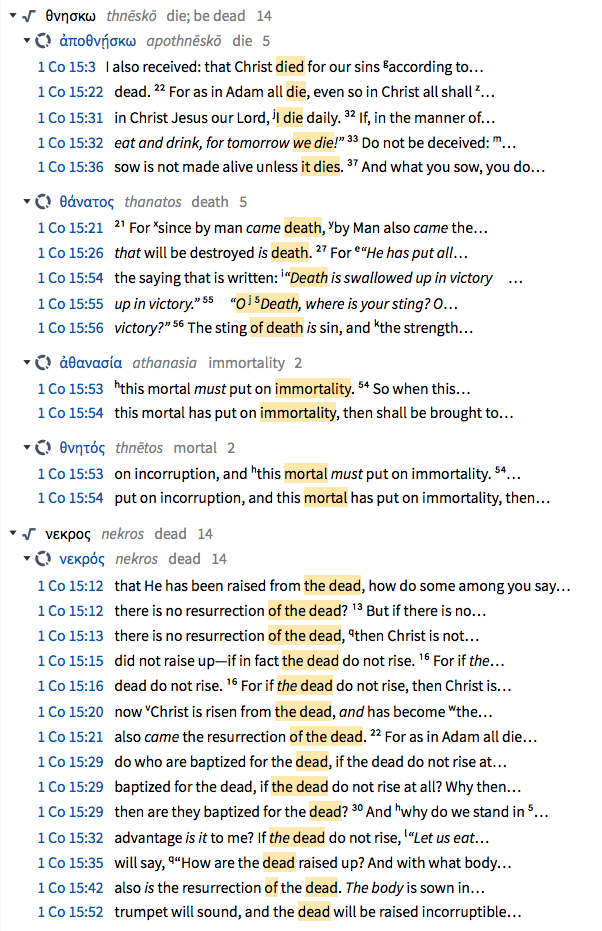
A related family of relevant, important words deal with the subject of ruin / corruption, which of course is the real present condition of our bodies awaiting death, and their reverse (incorruption) by the work of God. These words are given below:
The result of God’s work of resurrection is the giving of Spiritual life, something we possess now, but it is concealed and in many day-to-days ‘buried’ by the corruption of our flesh and bodies. The work of the Spirit occurs in these words given below in 1 Cor 15: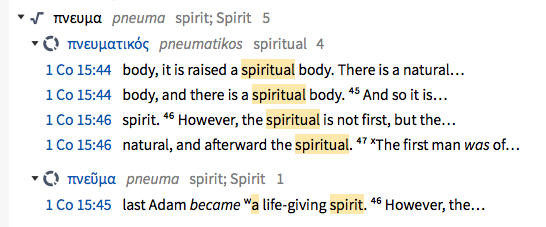
The ‘actor’ (Great Initiator) of the our resurrection is Christ in God. Those occurrences are below along with the many references to our “body:”
Imperative Verbs
The imperative verbs in 1 Cor 15 are shown below:
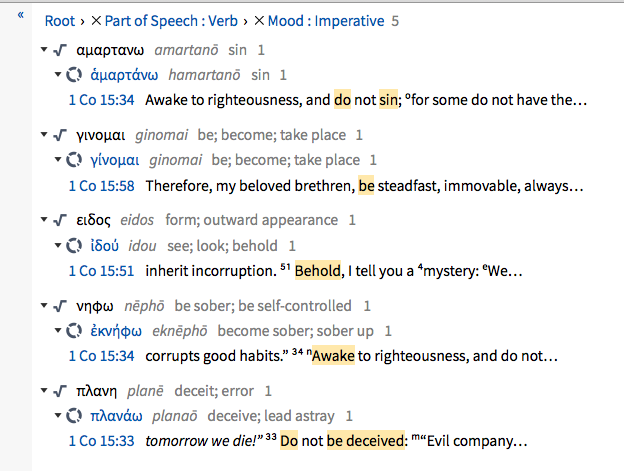
The Millennium
This chapter and parallel chapters opens the questions regarding the last days. One of the key words / ideas is the millennium, which means literally a 1,000 year period. (There are places where the Bible speaks of “a thousand years” in a general sense; the issue of “the millennium” is a specific, exact 1,000 year period of time).
Here is a summary of of the matter from a generally reliable source:
MILLENNIUM, THE — the thousand-year period mentioned in connection with the description of Christ’s coming to reign with His saints over the earth (Rev. 20:1–9). Many Old Testament passages are reputed to refer to the millennium (Is. 11:4; Jer. 3:17; Zech. 14:9).
These and many other Old Testament passages are often taken to refer only to the thousand-year period itself. However, it is often difficult in these passages to see a clear dividing line between the earthly period of the millennium and the eternal state of new heavens and earth. Therefore, it is best to let one’s teaching about the millennium be drawn specifically from the words in Revelation 20. The other great promises to Israel, while they may have a temporary fulfillment in the thousand years, still await the fulness of the new heavens and new earth and the unhindered presence of Israel’s king and the church’s husband—Jesus Christ our Lord.
During that thousand-year period, Satan will be bound in the bottomless pit so he will not deceive the nations until his short period of release (Rev. 20:3, 7–8). The faithful martyrs who have died for the cause of Christ will be resurrected before the millennium. They will rule with Christ and will be priests of God and Christ (Rev. 20:4). The unbelieving dead will wait for the second resurrection (Rev. 20:5). After the thousand years, Satan will be released and will again resume his work of deceit (Rev. 20:7–8).
The most important aspect of the millennium is the reign of Christ. Peter taught that Christ now rules from the right hand of God (Acts 2:33–36). That rule will last until His enemies are made His footstool “The Lord said to my Lord, ‘sit at My right hand, till I make Your enemies Your footstool’ ” (Ps. 110:1). The apostle Paul also understood Christ to be presently reigning in a period designed to bring all of God’s enemies underfoot (1 Cor. 15:25–27). Thus the impact of Christ’s present rule over the earth from God’s right hand must not be seen as unrelated to His future reign during the millennium.
The millennium is viewed by interpreters in several different ways. One position holds that the millennium only refers to Christ’s spiritual rule today from heaven. This symbolic view is known as the amillennial interpretation. Another position views Christ’s spiritual rule as working through preaching and teaching to bring gradual world improvement leading up to Christ’s return. This is the postmillennial view.
The position that holds to an actual thousand-year period in the future is known as the premillennial view. This interpretation does not diminish the power of Christ’s present rule from heaven or limit that rule to the church only. That position sees the need for a thousand-year place in history for an earthly fulfillment of Israel’s promises of land and blessing. It stresses that the one thousand years in Revelation 20 are actual years and are not symbolic.
Youngblood, R. F., Bruce, F. F., & Harrison, R. K., Thomas Nelson Publishers (Eds.). (1995). In Nelson’s new illustrated Bible dictionary. Nashville, TN: Thomas Nelson, Inc.
The postmillennial belief, namely that there is no literal 1,000 year period, was widespread in Christianity in the 19th Century bolstered likely by an underlying belief that the world was gradually become more evangelized and getting ‘better,’ in preparation for Christ’s return. Such a perspective parallels what the orthodox Jews believed at the time of Christ, namely that by their righteousness and adherence to the OT Scriptures, they were making ready and causing the time for the Messiah to come to restore all things. Of course the Gospels make clear that such perceived “righteousness” was false, and that the Messiah did come, but as the necessary Lamb of God to be the cause of righteous deliverance that man could never do. The wars of the 20th Century has pretty much accomplished the same realization for those who held the postmillennial confidence. The amillennial belief, namely the 1,000 year reference is purely symbolic / metaphorical, is commonly held by those who take such symbolic perspective toward much of Scripture; there is of course symbology in Scripture (Christ is “the road” but He is not flat and comprised of stones, bricks, or asphalt), but it is a very slippery slope to look first at a text as being only a picture of reality, not reality itself.
Millennial beliefs are commonly associated with “Dispensationalism,” namely that God has dealt with man in specific periods of time (ages)–some would say seven such periods, some say four, most everyone agrees that there was at least two (Old Testament and New). The issue of a literal 1,000 year period is not uniquely tied to dispensationalism: one can hold a premillennial understanding of Scripture–meaning that we are awaiting for the 1,000 year literal period to come–without being a dispensationalist in the full sense of that doctrine.
The key passage of the 1,000 year period is in Rev. 20 (below):
Revelation 20:1–10 (NKJV)
1 Then I saw an angel coming down from heaven, having the key to the bottomless pit and a great chain in his hand. 2 He laid hold of the dragon, that serpent of old, who is theDevil and Satan, and bound him for a thousand years; 3 and he cast him into the bottomless pit, and shut him up, and set a seal on him, so that he should deceive the nations no more till the thousand years were finished. But after these things he must be released for a little while. 4 And I saw thrones, and they sat on them, and judgment was committed to them. Then I sawthe souls of those who had been beheaded for their witness to Jesus and for the word of God, who had not worshiped the beast or his image, and had not received hismark on their foreheads or on their hands. And they lived and reigned with Christ for a thousand years. 5 But the rest of the dead did not live again until the thousand years were finished. This isthe first resurrection. 6 Blessed and holy ishe who has part in the first resurrection. Over such the second death has no power, but they shall be priests of God and of Christ, and shall reign with Him a thousand years. 7 Now when the thousand years have expired, Satan will be released from his prison 8 and will go out to deceive the nations which are in the four corners of the earth, Gog and Magog, to gather them together to battle, whose number isas the sand of the sea. 9 They went up on the breadth of the earth and surrounded the camp of the saints and the beloved city. And fire came down from God out of heaven and devoured them. 10 The devil, who deceived them, was cast into the lake of fire and brimstone where the beast and the false prophet are. And they will be tormented day and night forever and ever.
(Seems to me that such 1,000 year reference is to a literal period of time, yet to come, no man knows when, but it will be really wonderful, special, when it does).
Dispensation
The English word “dispensation” occurs in the Bible, one to four times, depending upon the translation: KJV has it 4x, the NKJV 2x, Lexham English Bible 3x, NET and NASB Bibles 1x.
The Gr word so translated by the word dispensation is: oikonomia, Strongs G3622. In the KJV it is so translated at: 1 Cor. 9:17; Eph 1:10, 3:2; and Col 1:25 (in every case Strongs G3622). In other translations, Eph 1:10, for instance, “dispensation” in the KJV is translated by “fullness of times,” “maturity of times,” “climax of times,” etc. All these translations are seeking to capture the Gr meaning that there was in the (then) past a period of time which has now been supplanted by a new period of time. Clearly this must include reference to the old period of time under the Mosaic Law, anticipating the Messiah (Christ), and the period that was brought in by the finished work of Jesus Christ on our behalf, evidenced by the resurrection and the giving of the Holy Spirit, our present time under the ministry of Grace. (However, those who were called of God in the OT was saved by Grace, but it was in anticipation of the future work of Christ as made evident by the Passover celebration).
The traditional contrary view to “dispensationalism”–the view that all of Scripture can be properly understood only by considering various distinct periods of time (such as seven such periods, as popularized by C.I. Schoffield in the study Bible published under his name), is contrasted with the view of “covenant theology.” This subject is too broad for this discussion.
__________________
1 Cor. Ch 16 study resources are here:
